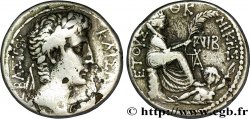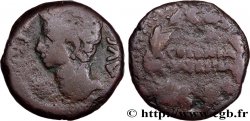v36_0356 - AUGUSTUS Unité
MONNAIES 36 (2008)
Startpreis : 100.00 €
Schätzung : 150.00 €
Erzielter Preis : 100.00 €
Anzahl der Gebote : 1
Höchstgebot : 111.00 €
Startpreis : 100.00 €
Schätzung : 150.00 €
Erzielter Preis : 100.00 €
Anzahl der Gebote : 1
Höchstgebot : 111.00 €
Type : Unité
Datum: 12 AC. - 14 AD.
Name der Münzstätte / Stadt : Acmonée, Phrygie
Metall : Kupfer
Durchmesser : 18,5 mm
Stempelstellung : 12 h.
Gewicht : 4,97 g.
Seltenheitsgrad : R2
Kommentare zum Erhaltungszustand:
Exemplaire sur un petit flan épais, bien centré des deux côtés, mais un peu court sur les légendes. Beau portrait. Faiblesse de frappe au revers. Patine marron foncé, légèrement granuleuse
Vorderseite
Beschreibung Vorderseite Tête nue d’Auguste à gauche (O°1) ; devant la tête un lituus.
Legende des Averses [S]EBASTOS
Übersetzung der Vorderseite (Auguste).
Rückseite
Beschreibung Rückseite Niké (Victoire) drapée, marchant à droite, brandissant une couronne de la main droite et tenant une palme de la main gauche.
Legende des Reverses : AKMONE[WN] - KORDOS
Übersetzung der Rückseite (Acmonéon - Cordos).
Kommentare
Pour ce type, les auteurs du Roman Provincial Coinage ont recensé six exemplaires avec six coins de droit, un poids moyen de 5,12 g pour quatre exemplaires. C’est le septième exemplaire signalé. Outre les deux exemplaires conservés à Londres, l’exemplaire du Cabinet des médailles de la BnF provient de la collection Waddington (n° 5484) et nous avons aussi un exemplaire à Berlin et un autre à Vienne. Le dernier est conservé au Staatliche museum de Münich. La présence du lituus devant le visage d’Auguste nous fait penser pour une datation postérieure à 13 avant J.-C. après la mort de Lépide quand Auguste recupère le titre de Pontifex Maximus (grand pontife), c’est à dire, chef de la religion traditionnelle romaine.
For this type, the authors of the Roman Provincial Coinage have identified six examples with six obverse dies, an average weight of 5.12 g for four examples. This is the seventh example reported. In addition to the two examples preserved in London, the example in the Cabinet des médailles of the BnF comes from the Waddington collection (no. 5484) and we also have one example in Berlin and another in Vienna. The last one is preserved at the Staatliche Museum in Munich. The presence of the lituus in front of the face of Augustus suggests a dating later than 13 BC after the death of Lepidus when Augustus recovered the title of Pontifex Maximus (high pontiff), that is to say, head of the traditional Roman religion.
For this type, the authors of the Roman Provincial Coinage have identified six examples with six obverse dies, an average weight of 5.12 g for four examples. This is the seventh example reported. In addition to the two examples preserved in London, the example in the Cabinet des médailles of the BnF comes from the Waddington collection (no. 5484) and we also have one example in Berlin and another in Vienna. The last one is preserved at the Staatliche Museum in Munich. The presence of the lituus in front of the face of Augustus suggests a dating later than 13 BC after the death of Lepidus when Augustus recovered the title of Pontifex Maximus (high pontiff), that is to say, head of the traditional Roman religion.








 Berichten über einen Fehler
Berichten über einen Fehler Die Seite drucken
Die Seite drucken Teilen meiner Auswahl
Teilen meiner Auswahl Stellen Sie eine Frage
Stellen Sie eine Frage Einlieferung/Verkauf
Einlieferung/Verkauf
 Details
Details









